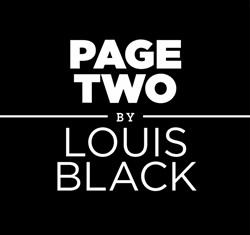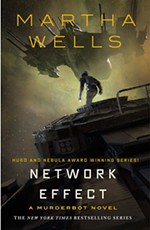Page Two: Wonder Stories
The unbound adventures and outrageous duets of a life spent with science fiction
By Louis Black, Fri., July 25, 2008

At the time, Harlem was so much fun, though still very much a ghetto with empty lots and burned-out empty buildings. It didn't turn really ugly there until crack became epidemic, which then was still many years away. Now Harlem is becoming a thriving, upscale community as African-Americans move back into the inner city, buying old houses and restoring them.
Despite my feeling comfortable in that community, nights could still be a little intense. The hospital where I was taken when I broke my arm was right across from a park. Although it never rose to even close to West Side Story action and melodrama, there was still all-night activity in the neighborhood and the park. Feeling very lonely, far from home (though I wasn't that far), and already well into an insomnia that was most pronounced only during the more reasonable times for sleep, I often would take a break from watching the evening to read. During the few days I was in there, I read Jack Vance's The Dying Earth and one of Lin Carter's Thongor books. Leaving the hospital, I had an arm in a cast and a new, enormous appetite for science fiction. I read everything I could find – and I could find a lot, because my friends were all SF readers.
Plunging in, I read the requisite giants of the time – Robert Heinlein, Isaac Asimov, Jack Vance, A.E. van Vogt, Damon Knight, and Frederik Pohl – as well as a lot of the pulp masters (I was reading a lot of pulps), including Edmond Hamilton and Lewis Padgett (Henry Kuttner and C.L. Moore). I read indiscriminately, not chronologically, so I'm probably messing up periods and leaving out dozens of authors. A "new wave" of SF writers of whom I was especially enamored emerged during the Sixties and included Roger Zelazny, Samuel R. Delaney, J.G. Ballard, and Michael Moorcock. There was also a handful of others who seemed to operate independent of linear chronologies: the extraordinary Harlan Ellison, Theodore Sturgeon, the hallucinatory Philip K. Dick, and Philip José Farmer.
To read this wonderful body of authors was to embark constantly on great, intellectual adventures unbound by the known, the three dimensions, and/or time. During this time, I attended a number of science-fiction conventions and other events; one of the highlights was invariably a seemingly spontaneous verbal confrontation between Harlan Ellison and Isaac Asimov. As my never-to-be-trusted memory has it, Asimov would usually be at the head of the room talking; Ellison and entourage would come slamming in through a back door and climb up on a table while hurling insults at Asimov, who would hurl them right back. I remember these outrageous, loud verbal duels as brilliant and hysterically funny.
By the time I got into reading science fiction intensely, I was already hanging out with Otto Binder, who lived in the town next to mine. I had gotten in touch with him because he was a famous comic-book writer, having authored the majority of the Fawcett Comics' Golden Age superhero Captain Marvel stories, as well as many stories of the Captain Marvel extended family. He wrote for most of the other major comic-book companies of the time, co-creating the Young Allies for Timely as well as writing for Captain America, the Sub-Mariner, and the Human Torch and co-creating Kid Eternity for Quality. After Fawcett went out of business in the wake of a lawsuit brought by DC Comics, Binder went back to writing for DC, co-creating the Legion of Super-Heroes, as well as writing for Superman and creating Brainiac and the Phantom Zone, while also writing most of the first wave of Bizarro stories. For years, I was lucky enough to hang out with Otto, discovering along the way that he had written a lot of science fiction for pulp magazines and was regarded as a major SF author from about 1939 to 1941, writing under the pseudonym of Eando Binder (his first half-dozen stories or so were co-written by Otto and Earl, his brother, but Otto kept the name even after his brother stopped writing for the most part).
As usual, through what proved to be a truly great adventure and extraordinary opportunity, I was oblivious, rude, and usually preoccupied. In his library, Otto had hundreds of SF pulp magazines, so I proceeded to read my way through those, often spending hours and hours at his home, reading while he wrote. Frequently, I would stop reading to ask him questions, disturbing him in exactly the same ways as I now hate to be interrupted when I'm writing.
Together, Otto and I attended a number of Lunacons, New York City/regional SF conventions. One time, as Otto tried to introduce me to his old friend Arthur C. Clarke, whom at that time I hadn't started reading yet, I literally almost pushed Clarke out of the way because I wanted to stare at Samuel Delaney, who was standing talking a few rows ahead of us. Pearls before swine, gourmet meals fed to those with fast-food appetites.
When I moved, the group with whom I socialized was made up of Austin science-fiction writers. These included Steve Utley, Lisa Tuttle, Chad Oliver, and Bruce Sterling. I read a short story by one of them about a postapocalyptic world in which Indians ran strings of rustled cars; it just blew me away. Another story was about dodo birds, long thought extinct, being alive in Arkansas, while yet another, co-written with Utley, was about the famous battle at Little Bighorn, though it involved biplanes. Those three stories – "Mary Margaret Road-Grader," "Ugly Chickens," and "Custer's Last Jump" – were joined by many others. There was a later story about Dwight Eisenhower as a jazz horn player and one in which Laurel and Hardy, the Marx Brothers, and the Three Stooges were slapstick-racing through Iowa to try to stop the Big Bopper, Buddy Holly, and Ritchie Valens from taking off into the snowy night sky, where their lives ended. Howard Waldrop wrote all those stories, and so many more – though I expect some editors, even those completely untrained in dentistry, would have had an easier job pulling teeth than they did getting those stories from Howard.
When I first moved to Austin, Howard was living with Bud Simons in a house deep in the avenues. We'd spend day after day hanging out there, talking about writers, writing, and movies. It wasn't until sometime later that I realized I should have discouraged Waldrop from talking about his favorite moments from his favorite movies rather than encouraging him. The problem was that whenever he described a scene from a movie I hadn't seen, by the time I did, the celluloid reality paled against Waldrop's memory. Memory and brilliance combined in one of the great imaginations to invariably improve whatever Hollywood writers had initially authored.
Now, there were warning signs that should have attracted more of my attention. One day Simons and Waldrop got into an afternoonlong argument over whether the first person to stand at the end of that epic to declare "I am Spartacus" was Tony Curtis or Harold J. Stone; Waldrop argued it was the latter. In those days before VHS, much less DVDs, there was no resolving this argument except to note that the most primitive understanding of Hollywood dramatic structure argued for Curtis. Waldrop, probably just thrilled because he knew the name of that great character actor, argued eloquently for Stone all afternoon, in no way being dissuaded by the mocking of others.
Sometime later, Howard moved from Austin; there really isn't any good fly-fishing here. He continued to write brilliantly and fish frequently, undoubtedly proving far more prolific at catching fish than finishing stories. Waldrop is back in town, but unfortunately he's ailing, recuperating from recent bypass surgery. I have no address for Waldrop, which seems appropriate in a way, but I bet if you get an e-mail or letter to Wayne Alan Brenner (brenner@austinchronicle.com), he'll get it to Waldrop (no phone calls to be conveyed, please!).
All these years later, so much of what happened runs together into a frequently chronologically impossible flow of memories. This issue is a special one devoted to science fiction. The Chronicle has done such issues in the past (see the cover that illustrates this column, for example), and we'll undoubtedly do more in the future.
This one, however, is dedicated to that great writer and our dear friend, Howard Waldrop.










